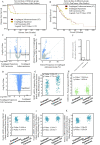Stem signatures associating SOX2 antibody helps to define diagnosis and prognosis prediction with esophageal cancer
- PMID: 35382656
- PMCID: PMC9004505
- DOI: 10.1080/07853890.2022.2056239
Stem signatures associating SOX2 antibody helps to define diagnosis and prognosis prediction with esophageal cancer
Abstract
Background: esophageal cancer is one of the deadliest diseases worldwide. Due to the ineffectual screening methods referring to early diagnosis, most people have lost their chance of radical resection when diagnosed with esophageal cancer. This aim of this study was designed to evaluate the latent values of the stem signatures-associated autoantibodies (AABS) in predicting the early diagnosis, and particularly seeking the precise predictive outcomes with sensitive SOX2. We also studied the potential immunotherapeutic targets and prospective long-term prognosis predicators of esophageal cancer.
Methods: The serum concentrations of selective antibodies were quantitated by enzyme-linked immunosorbent assay (ELISA), and a total of 203 local cases were enrolled. The TCGA databases were used to analyse distinct expression patterns and prognostic values of related genes. The TIMER database was used to explore the signatures of immune cell infiltration in related genes. The TISIDB database was used to analyse the association between related genes and immune regulators.
Results: The stem signatures-associated with antibodies of TP53, PGP9.5, SOX2, and CAGE were highly expressed in esophageal cancer and were negatively correlated with the test group, the diagnostic sensitivity of P53, SOX2, PGP9.5 and CAGE reached to 54.3%, 56.5%, 80.4% and 47.8%, respectively, and the specificity reached 77.7%, 93.6%, 76.4% and 86.6%. Especially in stage I esophageal cancer, the diagnostic sensitivity of SOX2 reached 82.4% with a specificity of 85.4%, which demonstrated good value in early diagnosis.
Conclusions: The stem signatures-associated antibodies could be used as an effective indicator in early esophageal cancer diagnosis and could help to precisely predicate survival and prognosis.Key MessagesThe stem signatures-associated immune-antibodies could be used as effective indicators in early diagnosis of esophageal cancer and help to precisely predicate the survival and prognosis.The potential immunotherapeutic targets referring to esophageal cancer are screened and analysed, and the high sensitivity of SOX2 in detecting early esophageal cancer will yield early and effective treatments.
Keywords: SOX2; Stem cells signatures; early diagnosis; immune infiltration evaluation; oesophageal cancer.
Conflict of interest statement
Authors declare each has approved this article to be published and that this research was conducted in the absence of any commercial or financial relationship that could be construed as a potential conflict of interest.
Figures





References
-
- Sung H, Ferlay J, Siegel RL, et al. . Global cancer statistics 2020: GLOBOCAN estimates of incidence and mortality worldwide for 36 cancers in 185 countries. CA A Cancer J Clin. 2021;71(3):209–249. - PubMed
-
- Siegel RL, Miller KD, Jemal A.. Cancer statistics, 2020. CA A Cancer J Clin. 2020;70(1):7–30. - PubMed
-
- Zerbib F, Omari T.. Oesophageal dysphagia: manifestations and diagnosis. Nat Rev Gastroenterol Hepatol. 2015;12(6):322–331. - PubMed
Publication types
MeSH terms
Substances
LinkOut - more resources
Full Text Sources
Other Literature Sources
Medical
Research Materials
Miscellaneous
